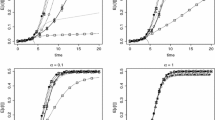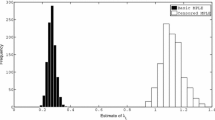Abstract
An SIS epidemiological model of individuals partitioned into households is studied, where infections take place either within or between households, the latter generally happening much less frequently. The model is explored using stochastic spatial simulations, as well as mathematical models which consist of an infinite system of ordinary differential equations for the moments of the distribution describing the proportions of individuals who are infectious among households. Various moment-closure approximations are used to truncate the system of ODEs to finite systems of equations. These approximations can sometimes lead to a system of ill-behaved ODEs which predict moments which become negative or unbounded. A reparametrization of the ODEs is then developed, which forces all moments to satisfy necessary constraints.
Changing the proportion of contacts within and between households does not change the endemic equilibrium, but does affect the amount of time it takes to approach the fixed point; increasing the proportion of contacts within households slows the spread of the infection toward endemic equilibrium. The system of moment equations does describe this phenomenon, although less accurately in the limit as the proportion of between-household contacts approaches zero. The results indicate that although controlling the movement of individuals does not affect the long-term frequency of an infection with SIS dynamics, it can have a large effect on the time-scale of the dynamics, which may provide an opportunity for other controls such as immunizations to be applied.
Similar content being viewed by others
References
Anderson, R.M., May, R.M., 1979. Population biology of infection diseases: Part I. Nature 280, 361–367.
Andersson, H., Britton, T., 1998. Heterogeneity in epidemic models and its effect on the spread of infection. J. Appl. Prob. 35, 651–661.
Ball, F., 1999. Stochastic and deterministic models for SIS epidemics among a population partitioned into households. Math. Biosci. 156, 41–67.
Ball, F., Mollison, D., Scalia-Tomba, G., 1997. Epidemics with two levels of mixing. Ann. Appl. Prob. 7(1), 46–89.
Ball, F., Neal, P., 2004. Poisson approximations for epidemics with two levels of mixing. Ann. Prob. 32(1B), 1168–1200.
Barthélemy, M., Barrat, A., Pastor-Satorras, R., Vespignani, A., 2005. Dynamical patterns of epidemic outbreaks in complex heterogeneous networks. J. Theor. Biol. 235, 275–288.
Bolker, B.M., 1999. Analytic models for the patchy spread of plant disease. Bull. Math. Biol. 61, 849–874.
Boots, M., Sasaki, A., 1999. ‘Small worlds’ and the evolution of virulence: Infection occurs locally and at a distance. Proc. R. Soc. Lond. B 266, 1933–1938.
Brown, D.H., Bolker, B.M., 2004. The effects of disease dispersal and host clustering on the epidemic threshold in plants. Bull. Math. Biol. 66, 341–371.
de Aguiar, M.A.M., Rauch, E.M., Bar-Yam, Y., 2003. Mean-field approximation to a spatial host-pathogen model. Phys. Rev. E 67, 047102.
Dieckmann, U., Law, R., 2000. Relaxation projections and the method of moments. In: Dieckmann, U., Law, R., Metz, J.A. (Eds.), The Geometry of Ecological Interactions, Ch. 21. Cambridge University Press, Cambridge, UK, pp. 412–455.
Ellner, S.P., Sasaki, A., Haraguchi, Y., Matsuda, H., 1998. Speed of invasion in lattice population models: Pair-edge approximations. J. Math. Biol. 36, 469–484.
Filipe, J.A.N., Gibson, G.J., 1998. Studying and approximating spatio-temporal models for epidemic spread and control. Phil. Trans. R. Soc. Lond. B 353, 2153–2162.
Filipe, J.A.N., Gibson, G.J., 2001. Comparing approximations to spatio-temporal models for epidemics with local spread. Bull. Math. Biol. 63, 603–624.
Filipe, J.A.N., Maule, M.M., 2004. Effects of dispersal mechanisms on spatio-temporal development of epidemics. J. Theor. Biol. 226, 125–141.
Filipe, J.A.N., Maule, M.M., Gilligan, C.A., 2004. On Analytical models for the patchy spread of plant disease. Bull. Math. Biol. 66, 1027–1037.
Ghoshal, G., Sander, L.M., Sokolov, I.M., 2004. SIS epidemics with household structure: The self-consistent field method. Math. Biosci. 190, 71–85.
Gutowitz, H.A., Victor, J.D., 1987. Local structure theory in more than one dimension. Complex Syst. 1, 57–68.
Gutowitz, H.A., Victor, J.D., Knight, B.W., 1987. Local structure theory for cellular automata. Physica D 28, 18–48.
Harada, Y., 1999. Short- vs. long-range disperser: The evolutionarily stable allocation in a lattice-structured habitat. J. Theor. Biol. 201, 171–187.
Harada, Y., Iwasa, Y., 1994. Lattice population dynamics for plants with dispersing seeds and vegetative propagation. Res. Popul. Ecol. 36(2), 237–249.
Hethcote, H.W., 1978. An immunization model for a heterogeneous population. Theor. Popul. Biol. 14, 338–349.
Hiebeler, D., 1997. Stochastic spatial models: From simulations to mean field and local structure approximations. J. Theor. Biol. 187, 307–319.
Hiebeler, D., 2000. Populations on fragmented landscapes with spatially structured heterogeneities: Landscape generation and local dispersal. Ecology 81(6), 1629–1641.
Hiebeler, D., 2004. Competition between near and far dispersers in spatially structured habitats. Theor. Popul. Biol. 66(3), 205–218.
Hiebeler, D., 2005a. A cellular automaton SIS epidemiological model with spatially clustered recoveries. Lec. Notes Comp. Sci. 3515, 360–367.
Hiebeler, D., 2005b. Spatially correlated disturbances in a locally dispersing population model. J. Theor. Biol. 232(1), 143–149.
Hwang, D.-U., Boccaletti, S., Moreno, Y., López-Ruiz, R., Apr. 2005. Thresholds for epidemic outbreaks in finite scale-free networks. Math. Biosci. Eng 2(2), 317–327.
Keeling, M., 2005. The implications of network structure for epidemic dynamics. Theor. Popul. Biol. 67, 1–8.
Keeling, M.J., 2000. Multiplicative moments and measures of persistence in ecology. J. Theor. Biol. 205, 269–281.
Kermack, W.O., McKendrick, A.G., 1927. A contribution to the mathematical theory of epidemics. Proc. R. Soc. Lond. A 115, 700–721.
Kirkwood, J.G., 1935. Statistical mechanics of fluid mixtures. J. Chem. Phys. 3, 300–313.
Levin, S.A., Durrett, R., 1996. From individuals to epidemics. Phil. Trans.: Biol. Sci. 351, 1615–1621.
Lloyd, A.L., 2004. Estimating variability in models for recurrent epidemics: Assessing the use of moment closure techniques. Theor. Popul. Biol. 65, 49–65.
Lloyd, A.L., Jansen, V.A., 2004. Spatiotemporal dynamics of epidemics: Synchrony in metapopulation models. Math. Biosci. 188, 1–16.
Matsuda, H., Ogita, N., Sasaki, A., Sato, K., 1992. Statistical mechanics of population. Prog. Theor. Phys. 88(6), 1035–1049.
May, R.M., Anderson, R.M., 1984. Spatial heterogeneity and the design of immunization programs. Math. Biosci. 72, 83–111.
Murrell, D.J., Dieckmann, U., Law, R., 2004. On moment closures for population dynamics in continuous space. J. Theor. Biol. 229, 421–432.
Newman, M.E.J., 2002. The spread of epidemic disease on networks. Phys. Rev. E 66, 016128.
Newman, M.E.J., Jensen, I., Ziff, R.M., 2002. Percolation and epidemics in a two-dimensional small world. Phys. Rev. E 65, 021904.
Pastor-Satorras, R., Vespignani, A., 2001. Epidemic spreading in scale-free networks. Phys. Rev. Let. 86(14), 3200–3203.
Petermann, T., De Los Rios, P., 2004a. Cluster approximations for epidemic processes: A systematic description of correlations beyond the pair level. J. Theor. Biol. 229, 1–11.
Petermann, T., De Los Rios, P., 2004b. The role of clustering and gridlike ordering in epidemic spreading. Phys. Rev. E 69, 066116. Doi: 10.1103/PhysRevE.69.066116.
Post, W.M., DeAngelis, D.L., Travis, C.C., 1983. Endemic disease in environments with spatially heterogeneous host populations. Math. Biosci. 63, 289–302.
Read, J.M., Keeling, M.J., 2003. Disease evolution on networks: The role of contact structure. Proc. R. Soc. Lond. B 270, 699–708.
Rushton, S., Mautner, A.J., 1955. The deterministic model of a simple epidemic for more than one community. Biometrika 42, 126–132.
Saramäki, J., Kaski, K., 2005. Modelling development of epidemics with dynamic small-world networks. J. Theor. Biol. 234, 413–421.
Watson, R.K., 1972. On an epidemic in a stratified population. J. Appl. Prob. 9, 659–666.
Watts, D.J., Muhamad, R., Medina, D.C., Dodds, P.S., 2005. Multiscale, resurgent epidemics in a hierarchical metapopulation model. Proc. Nat. Acad. Sci. 102, 11157–11162.
Author information
Authors and Affiliations
Corresponding author
Rights and permissions
About this article
Cite this article
Hiebeler, D. Moment Equations and Dynamics of a Household SIS Epidemiological Model. Bull. Math. Biol. 68, 1315–1333 (2006). https://doi.org/10.1007/s11538-006-9080-1
Received:
Accepted:
Published:
Issue Date:
DOI: https://doi.org/10.1007/s11538-006-9080-1




